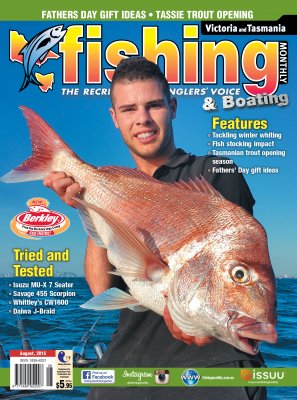Tackling winter whiting by Jarrod Day
 Winter means only one thing for a lot of anglers: time to garage the boat and wait until the cold fronts pass and the snapper migration kicks into gear again. It won't be long before this all happens, but for now we still have a month of winter left and plenty of hungry fish are still on offer.
Winter means only one thing for a lot of anglers: time to garage the boat and wait until the cold fronts pass and the snapper migration kicks into gear again. It won't be long before this all happens, but for now we still have a month of winter left and plenty of hungry fish are still on offer.
Once such species is the humble King George whiting. The run of winter whiting has been largely on the increase over the past few years, so they're definitely not just a summer target.
IT'S ALL ABOUT THE LOCATION
When it comes to locations, catching whiting throughout the cooler months is no different from catching them during the warmer months. The fish inhabit similar territory but do move about quite a bit, so finding a school of hungry fish can be quite time consuming.
Of the most popular locations, St Leonards on the Bellarine Peninsula and Blairgowrie on the Mornington Peninsula are the two most boasted about winter whiting haunts. In fact, even though these two locations get fished quite heavily they produce some remarkable fish.
Of course, it is not just these two locations that produce whiting throughout winter. Mornington, Mt Martha, Portsea and Sorrento are alive with these golden beauties too.
What all these locations have in common is the kind of habitat that can be found there: a mixture of weed beds and sand holes. From there the whiting seek out crustaceans to prey upon. Finding this type of ground is the key ingredient to finding whiting during both summer and winter.
BERLEY AND THEY WILL COME
Once you've found a likely location, your next challenge is to find the fish. During the summer months anglers tend to drop anchor, fish for 10 minutes and then (if they have no action) up anchor and move a few meters away before trying again. Some anglers might make 20 moves in a session until they find a school. Throughout winter, however, this approach isn't ideal. The fish are actually harder to locate this way.
An alternative method, and one that's highly successful, is using a concoction of berley. When you're attempting to find a school of fish, using a single bait in a large area won't bring the whole school to your immediate location, whereas a constant flow of fish offal can.
When it comes to berley there's no need to go overboard. Sometimes the 'KISS' (Keep It Simple Stupid) approach is best. Some anglers can't help but toss in unusual ingredients like dog food, cat food and who knows what else, but it's not necessary; a 1kg bag of frozen pilchards is more than enough to get the party started. Simply place the pilchards into a berley pot, mash them up a little and lower the pot to the seafloor. The force of the current will disperse the fishy scent and your trap will bet set.
CHANGING WITH THE TIMES
Targeting whiting throughout the winter period is a little different than during the summer months because the techniques vary according to how the fish react to the baits. Whiting are quite temperamental feeders at times. During one tide they can be aggressive while on the next tide they can be timid.
You should be able to pick up on their feeding habits after catching a few, and then you can switch tactics to further your success. If you're finding they're quite aggressive in taking your offerings, you might not have to worry about changing tactics at all. On the other hand, if you're finding the fish to be a little tentative, a minor change might be in order to be able to set the hook.